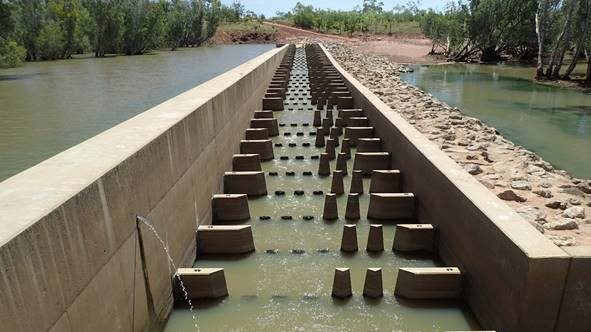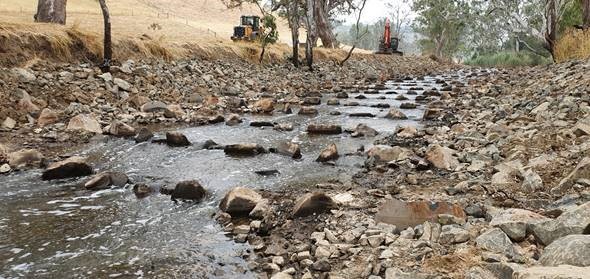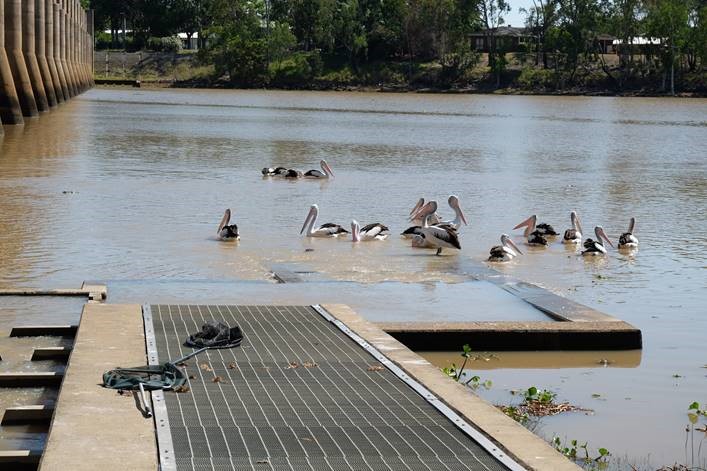OzFishers Building Fishways

Tim Marsden, President of the OzFish Hunter Chapter, is a consultant constructing fishways across Australia and South East Asia. Tim has finished his latest project so we thought it would be timely to have a yarn with him and talk about fishways.
What are fishways?
Fishways are structures placed at constructed barriers (such as dams or weirs) to give fish the opportunity to migrate. Many fish migrate upstream from or downstream into estuaries to breed and/or spawn. For many fish this is a critical part of their life cycle, without being able to make the journey up or downstream they simply cannot find the conditions they need successfully breed or spawn. And no baby fish means a rapidly declining population of some of our favourite species including Mullet, Herring, Mud Crabs, Barramundi, Bass, Jungle Perch, Eels, Yellow-belly, Murray Cod, Eastern Freshwater Cod and so many others.
Spawning upstream also gives juvenile fish a better chance of survival with fewer predators, more shelter and more food. Estuaries downstream have a larger capacity to hold sharks, rays and larger fish. Juveniles in open water like this do not stand a chance which is why these fish have a much better chance of survival upstream.
In the Hunter catchment there are rivers with many barriers that create a disconnected environment for fish. This means smaller fish get stranded in downstream where larger predators are a threat. Juvenile fish prefer to migrate upstream to where there is more shelter from these predators and a higher chance of survival. Also, the lack of connectivity can leave larger fish to be stranded in smaller sections of the river as water levels change.
“While we’re sampling, you can see how some sections of the waterways will have hundreds of juveniles and other smaller sections will have absolutely none. You can bet there is a big cod in there thats eaten them all and is left hungry.”
Types of fishways
There are several fishway designs.
Rock Ramps
The rock ramps look basic with just a few rows of stones protruding above the water. But, these stones design are complex and need to be placed in with machinery. The hydraulics of these designs are difficult to control but the environment inside gives places for smaller fish to rest. They make up the entire width of the channel so it’s no issue for fish to navigate.

Cone Fishways and Vertical Slot Designs
Vertical slot designs are associated with much bigger infrastructure projects, they look very synthetic, but the hydrology can be fine-tuned. Cone fishways were developed through the 2000s to assist in locations that a rock ramp would not suitable for but technically unfeasible due to the site. Since this time, Tim has installed several and has seen many fish passing through, from 15mm gudgeons to 1m round ray. See the video below of the whip ray passing through.

At face value, they look like simple structures, but each barrier represents a unique situation for construction. Aspects such as species diversity and size of the migrating fish community vary from site to site. Fishways are designed to cater for the physical characteristics and swimming abilities of the prevailing fish community. Smaller species of fish, which are weaker swimmers, are unable to negotiate the faster flows in a fishway. They simply cannot cross these fishways the same way large fish can. The hydraulic conditions within a fishway need to provide both enough depth for large fish whilst ensuring the velocity is suitable for smaller fish.
Tim has built several fishways in his career, to start off, it is worth mapping out the barriers along the catchment area and prioritising the barriers based on the ecological impacts. The barriers downstream are a higher priority because they have a higher impact on fish populations.
Secondly, economics would need to be considered. This is when you look at opportunities for funding from access to grants for individual landholders, right up to major projects such as dam constructions.

Many private landholders have barriers to waterways on their property such as vehicle accesses built into the river decades ago. Most landholders are not aware of the impacts these barriers cause to fish or that there is access to grants to fix these barriers. NGO groups might also think they cannot afford to construct fishways themselves.
“There are many solutions when you start looking. The first thing is simply making people aware that these barriers do block, and it does impact the fish population distribution and diversity”
Once constructed, the measure of success is the survival of the fish passing through, particularly the survival rate of juvenile fish. In fishways occurring in intertidal areas, birds have been known to move to these areas an hour before high tide to pick off the juveniles which accrue in high density at the entrance to move further upstream. Pelican predation occurs at the entrance to the Fitzroy Barrage Fishway during the migration of juvenile mullet into freshwater habitats. Underneath the pelicans, adult barramundi is also feeding.

In some designs (video below), catfish can also be seen in the fishway, hunting juveniles, not so much in the pools where the most fish are. Cleverly, they choose the pool upstream where the tired fish can be found fighting the velocity. Predation pressure is high, but even though some fish are eaten, the fishways allow many fish to still pass through the gauntlet of predators.
Without the fishway whole year classes of juvenile fish could be eaten by predators in estuarine waters. Juvenile fish typically school at high density, in very high numbers so the survival rate during these types of attacks is still sufficient for adequate recruitment upstream.
To give an idea of the numbers passing, refer to the video made below of the small fish predation occurring in the passageway – sound on.
Overall, fishways create a positive impact on the environment, in particular, the connectivity and resilience of fish populations upstream of catchment areas. OzFish members can exercise simple ground-truthing field trips to prioritise waterway barriers or raise funds for fishways in their chapter. Having people like Tim Marsden heading up our Chapters certainly helps create a scalable impact across Australia.
Credit to Tim Marsden for all the images and videos. Thanks, mate.
